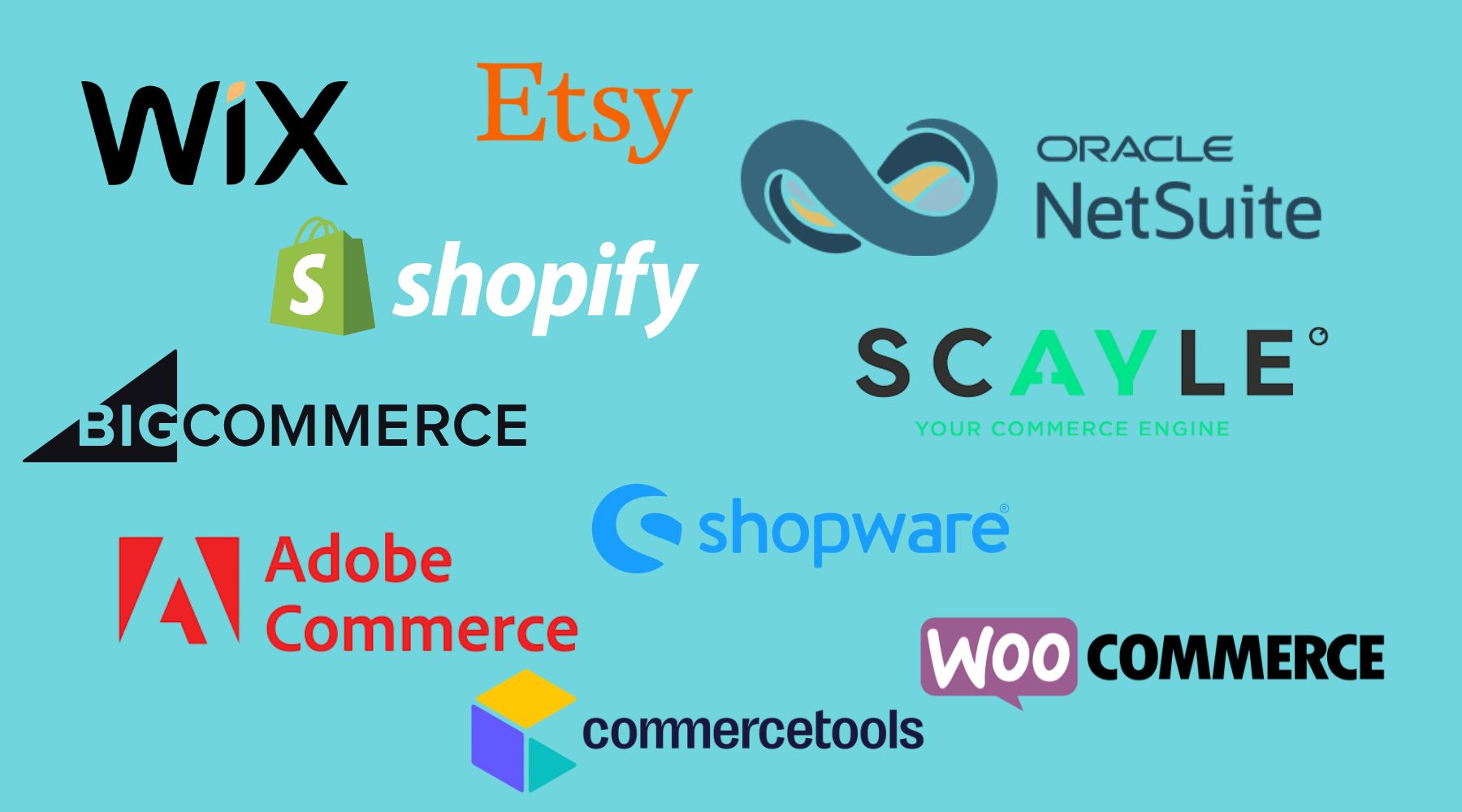If you want to build an online store, you need the right technical foundation. That foundation is provided by e-commerce shop systems, software solutions that enable you to manage products digitally, process payments, and organize your entire online sales workflow.
Many refer to them as an e-commerce platform or a shop system. In all cases, it describes the infrastructure on which your digital commerce is built.
The technical implementation varies significantly, and modern e-commerce systems generally fall into three main categories:
- SaaS (Software as a Service): Systems like Shopify are operated directly in the browser. Hosting, updates and security are included. You don’t need your own servers and can get started immediately.
- Open Source: Here, you work with the system’s source code, which you install, maintain and extend yourself. Platforms like WooCommerce or Shopware offer maximum flexibility but require technical expertise and ongoing maintenance.
- On-Premise: This model runs entirely within your own IT infrastructure. It is typically used by enterprises or organizations with strict data protection requirements.
For small and mid-sized businesses, it’s essential to choose a system that fits not only the product catalog but also the available budget and internal resources. An oversized platform won’t help you scale if you can’t operate or extend it efficiently.
For more insights on starting your project and choosing the right setup, take a look at our guide on selecting the right e-commerce agency.
Why choosing the right e-commerce platform is crucial
If you want to sell online, the platform you choose will shape the success of your entire business. Your shop system determines how customers buy, how efficiently your team works, and how well you can scale. From conversion rates to long-term performance, the platform is the technical foundation of your store.
A common mistake when choosing a system: thinking too short-term. Many merchants start with a simple solution, only to realize later that essential features are missing or that the system doesn’t scale. At that point, switching platforms becomes necessary, a process that costs time, money and energy.
The opposite happens as well: starting with an oversized enterprise system that slows you down and drains resources unnecessarily.
What matters is choosing a platform that fits your business model today and still supports your growth in six or twelve months.
Make sure to assess:
- How quickly can new features be integrated?
- How well does the shop perform as traffic increases?
- How flexibly can you adjust layouts, checkout flows or product logic?
If scaling is part of your strategy, you should also take a close look at enterprise solutions. Platforms like Shopify Plus offer the exact features needed for fast, sustainable growth.
You can learn more about this in our article on the Shopify Plus benefits.

Types of E-commerce Platforms at a Glance
There are many different e-commerce systems on the market, but not every platform is suitable for every project. What really matters is how much control, customization and maintenance you want to handle yourself.
In general, e-commerce platforms fall into three categories:
- SaaS platforms: Software-as-a-Service solutions like Wix, BigCommerce or Shopify are ideal if you want to launch quickly. You don’t need your own server infrastructure, and you benefit from automatic updates, strong security and fast setup processes. Most SaaS platforms come with intuitive drag-and-drop editors and built-in marketing features.
- Open-source systems: If you need maximum flexibility, systems like WooCommerce, Shopware or Magento are a strong fit. You get full access to the source code and can tailor the platform entirely to your needs. The downside: you’ll need a development team and must take care of hosting, updates and security yourself.
- Enterprise systems: For scaling brands and large, complex projects, enterprise solutions such as Commercetools, Scayle or Shopify Plus provide the right foundation. These platforms offer API-first architectures, headless flexibility, and powerful capabilities for international storefronts, multi-store environments and data-driven marketing.
A detailed comparison of Shopify Plus vs BigCommerce Enterprise can help you understand the key differences more clearly. You’ll also find valuable insights for complex setups in our Commercetools vs Shopify comparison.
The Best E-Commerce Platforms Compared in 2025
Not every shop system is the same. Depending on your budget, target audience, and business model, you need different features, different levels of flexibility and a different technical foundation.
In the table below, you can see at a glance how six of the most popular e-commerce platforms differ:
|
platform |
Pricing model |
Target group |
Special features |
|
Shopify (Basic – Advanced) |
SaaS, from approx. €27 (Basic) to approx. €384 (Advanced) per month |
Startups, growing D2C brands |
Fast setup, huge app store, intuitive operation, ideal for fast go-to-market, comparison with WooCommerce, Shopware, Magento |
|
Shopify Plus |
Enterprise SaaS, starting at approximately $2,000 per month |
Scaling Brands & Enterprise Teams |
API-first, multichannel with Shopify Markets, headless possible, comparison with BigCommerce Enterprise, Commercetools, Scayle |
|
WooCommerce |
Open source, hosting & plugins are subject to payment |
WordPress users, SMEs with tech experience |
Own hosting, flexible & developer-friendly, high maintenance effort, comparison with Shopify |
|
Shopware |
Open source (community) or SaaS (from Rise tariff) |
SMEs & medium-sized businesses in the DACH region |
Strong CMS functionality, made in Germany, API-driven, comparison with Shopify |
|
Magento (Adobe Commerce) |
Open Source & Enterprise (license costs on request) |
Corporations, B2B commerce with complex requirements |
Highly customizable, large development team required, Magento vs Shopify |
|
Wix eCommerce |
SaaS, from approx. €20/month |
Sole proprietors & creatives |
Simple modular principle, fast implementation, limited scalability, Wix vs Shopify |
|
Scayle |
License & revenue-based (custom pricing) |
High-volume fashion & lifestyle brands |
Headless, high-performance multi-store solution, also suitable for marketplaces |
What Features Should an E-Commerce Platform Absolutely Offer?
A good e-commerce platform is far more than a digital shopping cart. When choosing a system, you should pay close attention to core features that determine whether your experience will be successful or frustrating in the long run. What matters most: the platform must support not only today’s requirements, but also your future growth.
Essential features at a glance:
- Product management : Variants, stock levels, digital products and bundles must be easy to maintain
- Payment providers : The platform should integrate common providers such as PayPal, Klarna, credit card or Apple Pay as standard
- Shipping & Taxes : Automated tax rates and configurable shipping zones help you scale
- Multichannel capability : Your products should not only be visible in your own shop, but also on platforms such as Instagram, Amazon or eBay
- Legal certainty : GDPR-compliant cookie banners, cancellation policy, terms and conditions and invoicing – ideally solvable directly via plugin
- SEO & CRO features : Structured URL handling, loading times, meta fields and conversion optimizations such as upselling, bundles and one-click purchase
Beyond these fundamentals, the system’s extensibility becomes essential. If you plan a B2B setup or hybrid models like B2B2C, you’ll need flexible API integrations and a stable ecosystem with reliable extensions.
Some platforms offer specialized conversion optimization tools directly within the system. You’ll find more details in our guide on Shopify Plus CRO Services.

Shopify in Focus: Why So Many Brands Choose This Platform
If you’re working in e-commerce, it’s almost impossible to overlook Shopify. The platform is one of the most popular globally, mainly because it’s easy to get started and it scales smoothly as your business grows.
What brands appreciate about Shopify:
- You don’t need a development team to get started.
- Themes, payment providers, taxes, and shipping can be configured within a few clicks.
- The App Store offers thousands of extensions, from email marketing to inventory management.
- Multichannel selling works right out of the box, across social media and marketplaces alike.
As your business expands, you can scale within the same ecosystem. Upgrading from a basic plan to Shopify Advanced or Plus requires no platform migration. With Shopify Plus, you gain access to advanced APIs, stronger automation features, and a customizable checkout.
In short: Shopify is ideal for ambitious beginners, while Shopify Plus is designed for fast-growing brands with enterprise-level demands. You can find a detailed comparison in Shopify Advanced vs Shopify Plus.
If you need professional support, you’ll find a specialized Shopify Plus agency that can assist with setup, migration, or custom development.
Enterprise E-Commerce Platforms: A Direct Comparison
If you're evaluating e-commerce platforms for large product catalogs, international markets, or complex workflows, enterprise systems operate in a category of their own.
At this level, it’s not just about design or user-friendly interfaces. It’s about scalability, API logic, performance, and deep customization options. Shopify Plus is a strong contender here, but how does it compare to other enterprise-grade solutions?
Shopify Plus vs. Magento
Magento targets development-heavy teams that need maximum flexibility. As an open-source platform, you can customize virtually anything, but you also need substantial resources, ongoing maintenance, and technical oversight.
Shopify Plus takes the SaaS-first approach with powerful API access. You start with a stable core and extend it without rebuilding the entire system.
Full breakdown here: Shopify Plus vs Magento.
Shopify Plus vs. NetSuite
NetSuite isn’t just a commerce solution, it’s a full ERP system with commerce capabilities built in. Its strength lies in operations, finance, and enterprise governance.
Shopify Plus, on the other hand, focuses purely on commerce-first performance, fast implementation, and an extensive partner ecosystem. If selling is your priority, Shopify Plus is often the leaner choice.
Read more: Shopify Plus vs NetSuite.
Shopify Plus vs. Zoey
Zoey specializes in B2B commerce. Features like tiered pricing, customer roles, and quotation workflows are available out of the box.
Shopify Plus can also handle B2B through apps and APIs, while giving you greater brand flexibility and creative freedom.
See the comparison: Zoey vs Shopify Plus.
Shopify Plus vs. Scayle
Scayle, powered by the About You tech stack, is a headless system built for content-driven commerce. You get maximum control, but only if you have an enterprise-level development setup behind it.
Shopify Plus offers far more comfort and ready-to-use functionality, ideal for teams that want to launch quickly without heavy engineering.
Full comparison: Scayle vs Shopify Plus.
Shopify Plus vs Commercetools
Commercetools is built on Composable Commerce principles: your store is assembled from microservices, APIs, and custom frontends. That means full flexibility, but also significant setup and ongoing development efforts.
Shopify Plus, by contrast, provides a structured environment with plug-and-play features while still offering extensive API freedom.
Complete overview: Commercetools vs Shopify Plus.
Differences at a glance
|
category |
Shopify Plus |
Magento |
NetSuite |
Zoey |
Scayle |
Commerce tools |
|
System type |
SaaS with API access |
Open Source |
ERP with commerce module |
B2B-focused SaaS system |
Headless Commerce Stack |
Composable Commerce Platform |
|
Technical entry barrier |
Low to medium |
High (dev-heavy) |
High |
Medium |
High |
High |
|
B2B functions |
Expandable via app/API |
Native B2B modules available |
Possible, but focus is on ERP |
B2B features natively |
Possible with individual development |
Headless B2B with microservices |
|
Headless Ready |
Yes, API-first with Storefront API |
Yes, about additional development |
Restricted |
No (not in focus) |
Yes, content & commerce strictly separated |
Yes, headless & API-centric |
|
Design flexibility |
High, with themes or Liquid Code |
Very high (completely individual) |
Low, because ERP-based |
Medium (B2B templates) |
Very high, completely individual |
Very high, but frontend must be built completely |
|
Speed during setup |
Fast, because preconfigured |
Slow (depending on the team) |
Slow (ERP implementation) |
Medium |
Medium to long |
Long (complex architecture) |
|
Adaptability / Flexibility |
High with extensions and API |
Extremely high |
Strong, but only through partners |
Medium |
Extremely high |
Extremely high |
|
Cost structure |
Sure, from $2,000/month depending on sales |
Variable, high initial costs due to development |
Expensive, license and consulting costs |
Fixed prices, graduated according to the number of customers |
Depending on project volume, usually enterprise level |
Individual pricing, depending on the setup |
|
Support & partner network |
Large global agency and developer network |
Strong, but often agency-bound |
Only through authorized partners |
Smaller network |
More in-house driven |
Focus on individual enterprise support |
|
Suitable for |
D2C, B2C, fast-growing brands |
Brands with their own development team, high level of customization |
Companies with an ERP focus |
B2B shops with medium setup requirements |
Content commerce brands with development team |
Corporations with a microservice strategy and their own development team |
|
Comparison article |
Shopify Plus vs Magento |
Shopify Plus vs Magento |
Shopify Plus vs NetSuite |
Zoey vs Shopify Plus |
Scayle vs Shopify Plus |

Shop systems for Digital Products, Subscriptions & Niche Models
Not every online business needs a full-scale shop system with inventory management and shipping modules. If you sell digital products, coaching programs, memberships, or online courses, flexibility becomes the top priority. What matters is that your platform supports digital downloads, recurring payments, and secure access management.
Shopify can be adapted very easily for these use cases, through apps for digital downloads, online courses, and subscription products.
If you only offer a small collection of digital items, Etsy may also be an option. You gain instant access to an existing audience, but you sacrifice control over design, branding, and customer data.
You'll find a detailed breakdown in our comparison: Shopify vs Etsy.
Beyond traditional shop systems, there are also specialized platforms designed specifically for digital businesses, often without requiring a dedicated online shop.
Popular examples include:
- Digistore24: Billing, hosting, and an affiliate network for digital products
- Thinkific: A course platform with payments, community features, and certificates
- Copecart: Similar to Digistore, with a strong focus on German-speaking creators
These tools offer an all-in-one setup, but they lack the design freedom and branding possibilities of a classic e-commerce platform. If your long-term goal is strong branding, content-driven growth, or building a community, a customizable system (e.g., Shopify) will serve you better.
How to Choose the Right E-Commerce Platform – 9 Practical Tips
Choosing a shop system isn’t a gut decision. It requires clear criteria and a structured evaluation.
These nine points help you navigate the selection process with confidence:
- Define your budget: What monthly fixed costs can you realistically support?
- Assess scalability: How easily can the platform grow with your business?
- Understand your target audience: Do you need mobile-first UX or multichannel capabilities?
- Analyze internal workflows: How do you handle product updates, fulfillment, and support?
- Test usability & backend logic: Can your team operate the system without friction?
- Check update & security standards: Is the platform actively maintained and future-proof?
- Verify available integrations: Do you require ERP, PIM, or CRM connections?
- Evaluate support quality: Is there a strong partner ecosystem, community, or 24/7 support?
- Identify development partners: Essential if you plan to build custom features later.
If you need expert support with platform selection or technical implementation, our Shopify Plus Development Agency and the overview of our Shopify Plus Development Services provide exactly that.
We also recommend creating a simple decision matrix: Define weighted criteria, score each platform, and compare the totals. This prevents costly misjudgments and gives you a clear, data-driven foundation for your choice.
When You Should Switch to a New E-Commerce Platform
If your current shop system is hitting its limits, it’s often a sign that your business has outgrown the platform, or that new requirements can no longer be handled efficiently.
These indicators strongly suggest it’s time for a change:
- Technical limitations: If integrations stop working, essential APIs are missing, or loading times increase, your conversion rate inevitably drops.
- Growth is overwhelming the system: More products, more traffic, or new international markets require stable scaling and automated workflows.
- Missing features: Whether it's multichannel selling, B2B logic, or subscription models, if critical capabilities are absent, your business will feel the brake.
Before making the switch, go through these steps systematically:
- System analysis and clear objective setting
- Exporting all data (products, customers, orders)
- Detailed SEO migration plan
- Testing phase in the new system
- Gradual migration with proper redirect management
Pro tip: If you're moving to Shopify or another enterprise-level platform, partnering with an experienced Shopify Plus agency ensures a smooth, risk-free transition.
Conclusion – Choosing the Right Platform for Sustainable E-Commerce Success
E-commerce platforms differ not just in their look and feel but, far more importantly, in their technical foundations. SaaS solutions like Shopify or Wix offer easy handling and minimal maintenance. Open-source platforms like Shopware or Magento provide maximum customizability but require significantly more development resources.
Our recommendation by business size:
- Beginners & solopreneurs: SaaS platforms like Shopify or Wix
- SMBs with in-house IT resources: Shopware, WooCommerce, or Shopify Advanced
- Enterprise level: Shopify Plus, Commercetools, or Scayle
If you’re unsure which system best fits your business, our e-commerce agency can provide an independent evaluation, ensuring your platform doesn’t just work, but grows with you.








